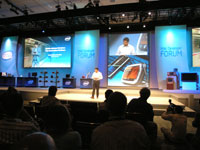IDF Day 2: Anand Chandrasekher: "MIDs: Platform for Innovation"
IDF Day 2: Anand Chandrasekher: "MIDs: Platform for Innovation"
Day two of IDF kicked off with a cheesy, classic Star Trek opening-credits rip-off that concluded with the statement: "The Internet, to boldly go where it has never gone before: in your pocket." Then it was Senior Vice President and General Manager of Intel's Ultra Mobility Group, Anand Chandrasekher's turn to present his keynote on the state of today's and tomorrow's MIDs (Mobile Internet Devices).
Chandrasekher says that in June, the number of people who used the Internet was roughly equal to three times the population of the U.S. Chandrasekher also said that we are now at an inflection point in regards to Internet access--although he didn't actually specify if he thought if it was trending down or up. Chandrasekher showed how Internet usage has changed in last 10 years by looking at the top 10 Websites in 1999, 2005, and 2008. Social networking has become an increasingly popular presence on the Web these last few years. He says the Internet is still very young and will continue to change even more in the next decade.
The direction Chandrasekher sees the Internet going is one where people can take their Internet experiences with them, wherever they go. And once that Internet experience is untethered, he sees a much greater growth of Internet usage. Regardless, he sees the mobile Internet as a driving force behind the directions the Internet will start taking, and the platform that he envisions will enable all of this are MIDs.
Chandrasekher and "Russ" (yet another demo assistant who is never introduced by his surname) demonstrated a MID running a ported version of the location-based, social networking application, GyPSii. With the app, they looked up where their friends were currently located and found local restaurant recommendations. Chandrasekher sites this as an example of social networking, location info, user-generated content, and the Internet all coming together.
As the Internet advanced over time, how people engaged with it changed from primarily text, to pictures, to video, to user-generated content. As it advanced, it became more visually rich and more contextual. For it to continue to advance and become truly untethered, Chandrasekher says four needs need to happen:
Chandrasekher says that in June, the number of people who used the Internet was roughly equal to three times the population of the U.S. Chandrasekher also said that we are now at an inflection point in regards to Internet access--although he didn't actually specify if he thought if it was trending down or up. Chandrasekher showed how Internet usage has changed in last 10 years by looking at the top 10 Websites in 1999, 2005, and 2008. Social networking has become an increasingly popular presence on the Web these last few years. He says the Internet is still very young and will continue to change even more in the next decade.
The direction Chandrasekher sees the Internet going is one where people can take their Internet experiences with them, wherever they go. And once that Internet experience is untethered, he sees a much greater growth of Internet usage. Regardless, he sees the mobile Internet as a driving force behind the directions the Internet will start taking, and the platform that he envisions will enable all of this are MIDs.
Chandrasekher and "Russ" (yet another demo assistant who is never introduced by his surname) demonstrated a MID running a ported version of the location-based, social networking application, GyPSii. With the app, they looked up where their friends were currently located and found local restaurant recommendations. Chandrasekher sites this as an example of social networking, location info, user-generated content, and the Internet all coming together.
As the Internet advanced over time, how people engaged with it changed from primarily text, to pictures, to video, to user-generated content. As it advanced, it became more visually rich and more contextual. For it to continue to advance and become truly untethered, Chandrasekher says four needs need to happen:
- Devices need to be high performance, but run at low power
- Devices need to support the latest rich media Internet technologies
- Devices need to support compatible software so that developers can develop applications for them
- Devices need to support always-on connectivity














